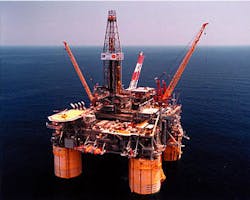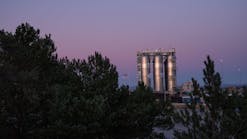The Brutus TLP is 3,250 ft high, from the seafloor to the crown block of the drilling rig and is located in 2,985-ft of water (Fig. 1).
In August, Shell Exploration & Production Co. (SEPCo) began oil and gas production from its 100%-owned Brutus tension leg platform (TLP), its fifth TLP in the Gulf of Mexico. Brutus is in 2,985 ft of water in Green Canyon Block 158.
SEPCo says Brutus, an eight-slot TLP, is its first deepwater platform to be specifically designed to serve as a hub for future subsea developments in the surrounding area, although several of its platforms have been previously retrofitted to serve as hubs.
Matthias Bichsel, director deepwater services, Shell International Exploration and Production Inc. said "Working seamlessly with the SEPCo staff, we developed and executed a plan that completed the Brutus project 7 months earlier than the previous best completion time and 18% below our cost benchmark, which was the Ram Powell project."
The Ram Powell TLP is in 3,214 ft of water and production through it started in May 1997.
Raoul Restucci, president and CEO of SEPCo commented that though viable as a stand-alone project, the Brutus field will be used as a hub to accommodate future production from surrounding areas. He said Shell's strategy is to establish and leverage significant infrastructure points in the deepwater Gulf of Mexico, so that a strong infrastructure creates an economic and competitive advantage and minimizes the environmental footprint of future operations.
Shell's deepwater services was responsible for design, construction, and installation of the TLP system and pipelines, while SEPCo is responsible for subsurface evaluation and management, drilling, completion, and production operations.
Production, development
Brutus produces from Blocks 158 and 202, which have water depths ranging from 2,750 to 3,300 ft. Shell Offshore Inc. owns 100% of the leases and acquired them in Lease Sale 98 in March 1985, paying a total bonus of $15.5 million.
It drilled the discovery well on Green Canyon Block 158 in December 1988 and an appraisal well on Green Canyon Block 158 in 1994. A third well was drilled in 1997 on that same block, with a bottomhole location on Green Canyon Block 202.
It says target reservoirs are in the Plio-Pleistocene sands at12,500-17,500 ft subsea.
The development phase included batch setting eight wells with Diamond's Ocean Worker semisubmersible drilling rig. Following the batch set operation, six of the planned development wells for the eight-slot TLP were subsequently predrilled to total depth with the Ocean Worker. This work was concluded in April 2001.
It plans to drill further development wells with an H&P platform rig, determining the final number of wells needed after evaluating the field's production performance.
Produced oil enters a 26-mile, 20-in. pipeline to South Timbalier 301 B platform where it connects to the existing Amberjack System. Produced gas enters a 24-mile, 20-in. pipeline that connects the TLP to the existing Manta Ray Offshore Gathering System in Ship Shoal Block 332.
Brutus facts
The Brutus TLP is 3,250 ft high, from the seafloor to the crown block of the drilling rig. SEPCo says although similar in size and configuration to its Mars and Ram Powell TLPs, Brutus was designed with increased displacement to handle subsea tiebacks and with dual processing systems for its role as a hub.
It expects total project cost to be less than $750 million, including pipelines but excluding lease costs. About 75% of the costs are associated with fabrication and installation of the hull, deck, facilities, drilling rig, and pipeline. The other 25% relate to drilling and completing wells.
Heerema's derrick barge, Hermod installed the TLP in June 2001.
The hull has four circular steel columns, 66.5 ft in diameter and 166 ft high. Pontoons, which connect the columns, are 35.5-ft wide and 23-ft high, with a rectangular cross section.
The hull weighs about 13,500 tons, with a total displacement of 54,700 tons.
Daewoo Heavy Industries Co. of South Korea built the hull. On December 7, 2000, the hull left Daewoo's Okpo fabrication yard, transported by Dockwise's Mighty Servant 3. The hull arrived at CSO Gulf Maritime's integration facilities near Ingleside, Tex. on January 30, 2001, for installation of the topsides modules.
The installed deck has dimensions at the outside truss rows of 245 sq ft and is about 40-ft high. The deck is composed of five modules: process, drilling, power, quarters, and well bay.
Deck modules have an open truss frame design with a total structural steel weight of about 7,650 tons. Total topside weight is 22,000 tons, including all process equipment and the drilling rig. J. Ray McDermott built the modules at its Amelia, La. fabrication yard. The modules arrived at the CSO Gulf Marine integration yard in January and February 2001.
A specialized device lifted the five deck modules into position on the hull. The device was originally developed for the Mars TLP integration.
The Brutus TLP has 12 tendons, 3 per corner, each with a 32-in. diameter and 1.25-in. wall thickness. Each tendon is about 2,900-ft long, with the 12 tendons weighing about 7,500 tons.
The tendons are attached to a TLP foundation system with 12, 245 ton, 82-in., 340-ft long piles.



